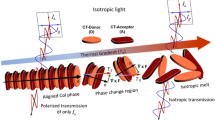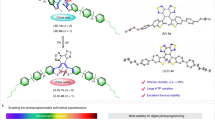Abstract
Materials with light-controlled properties are extremely attractive for information technologies and, among the wide range of approaches, that of photorefractive media is particularly relevant1,2. Photorefractivity is observed in photoconductors, where charge carriers photogenerated by non-uniform illumination redistribute over macroscopic distances, and where the resulting electric field modulates the refractive index. This effect has been used in a variety of devices for applications ranging from image treatment to beam steering and medical imaging. Compared with the more commonly studied inorganic crystals, photorefractive non-crystalline organic systems3,4,5,6 offer a more technologically appealing alternative, as these materials are mechanically flexible, can be easily modified chemically and are inexpensive. Here we show how a photogenerated space–charge field can be used to control the switching between the two stable orientational states of ferroelectric liquid crystals. The resulting refractive-index patterns are stable, easily erasable and rewritable. In contrast to more traditional organic photorefractive materials, where the refractive index is continuously modulated by the applied field, the liquid-crystalline device described here is a ‘binary’ system, in which the refractive index n switches between two values (Δn∼3×10−2 in this case, but Δn of the order of 10−1 is, in principle, possible).
This is a preview of subscription content, access via your institution
Access options
Subscribe to this journal
Receive 12 print issues and online access
$259.00 per year
only $21.58 per issue
Buy this article
- Purchase on Springer Link
- Instant access to full article PDF
Prices may be subject to local taxes which are calculated during checkout




Similar content being viewed by others
References
Yeh, P. Introduction to Photorefractive Nonlinear Optics (Wiley, New York, 1993).
Solymar, L., Webb, D. J. & Grunnet-Jepsen, A. The Physics and Applications of Photorefractive Materials (Clarendon, Oxford, 1996).
Ducharme, S., Scott, J. C., Twieg, R. J. & Moerner, W. E. Observation of the photorefractive effect in a polymer. Phys. Rev. Lett. 66, 1846–1849 (1991).
Meerholz, K., Volodin, B. L., Sandalphon, Kippelen, B. & Peyghambarian, N. A photorefractive polymer with high optical gain and diffraction efficiency near 100%. Nature 371, 497–500 (1994).
Montemezzani, G., Medrano, C., Zgonik, M. & Günter, P. in Nonlinear Optical Effects and Materials (ed. Günter, P.) 301–373 (Springer, Berlin, 2000).
Ostroverkhova, O. & Moerner, W. E. Organic photorefractives: mechanisms, materials and applications. Chem. Rev. 104, 3267–3314 (2004).
Rudenko, E. V. & Sukhov, A. V. Photoinduced electrical conductivity and photorefraction in nematic liquid crystal. JETP Lett. 59, 142–146 (1994).
Khoo, I. C., Li, H. & Liang, Y. Observation of orientational photorefractive effects in nematic liquid crystals. Opt. Lett. 19, 1723–1725 (1994).
Wiederrecht, G. P., Yoon, B. A. & Wasielewski, M. R. High photorefractive gain in nematic liquid crystals doped with electron donor and acceptor molecules. Science 270, 1794–1797 (1995).
Wiederrecht, G. P., Yoon, B. A. & Wasielewski, M. R. Photorefractivity in ferroelectric liquid crystal composites containing electron donor and acceptor molecules. Adv. Mater. 12, 1533–1536 (2000).
Sasaki, T. et al. Spontaneous polarization-vector-reorientation photorefractive effect in ferroelectric liquid crystals. Appl. Phys. Lett. 78, 4112–4114 (2001).
Termine, R., De Simone, B. C. & Golemme, A. Photorefractive chiral smectic A phases. Appl. Phys. Lett. 78, 688–690 (2001).
Talarico, M., Barberio, G., Pucci, D., Ghedini, M. & Golemme, A. Undoped photorefractive ferroelectric liquid crystal. Adv. Mater. 15, 1374–1377 (2003).
Lagerwall, S. T. Ferroelectric and Antiferroelectric Liquid Crystals (Wiley–VCH, Weinheim, 1999).
Muševič, I., Blinc, R. & Žekš, B. The Physics of Ferroelectric and Antiferroelectric Liquid Crystals (World Scientific, Singapore, 2000).
Clark, N. A. & Lagerwall, S. T. Submicrosecond bistable electro-optic switching in liquid crystals. Appl. Phys. Lett. 36, 899–901 (1980).
Ikeda, T., Sasaki, T. & Ichimura, K. Photochemical switching of polarization in ferroelectric liquid crystal films. Nature 361, 428–430 (1993).
Khoo, I. C., Guenther, B. D., Wood, M. V., Chen, P. & Shih, M. Y. Coherent beam amplification with a photorefractive liquid crystal. Opt. Lett. 22, 1229–1231 (1997).
Khoo, I. C., Ding, J., Zhang, Y., Chen, K. & Diaz, A. Supra-nonlinear photorefractive response in single-walled carbon nanotube- andC60-doped nematic liquid crystals. Appl. Phys. Lett. 82, 3587–3589 (2003).
Kaczmarek, M., Dyadyusha, A., Slussarenko, S. & Khoo, I. C. The role of surface charge field in two-beam coupling in liquid crystal cells with photoconducting polymer layers. J. Appl. Phys. 96, 2616–2623 (2004).
Sutter, K. & Günter, P. Photorefractive gratings in the organic crystal 2-cyclooctylamino-5-nitropyridine doped with 7,7,8,8-tetracyanoquinodimethane. J. Opt. Soc. Am. B 7, 2274–2278 (1990).
Termine, R. & Golemme, A. Photorefractive index modulation in chiral smectic phases. J. Phys. Chem. B 106, 4105–4111 (2002).
Acknowledgements
We thank L. Blinov for discussions. The liquid crystal L-15278 used in this study was a generous gift from M. Radcliffe. This work has been partially supported by MIUR under the projects Molecular and Organic/Inorganic Hybrid Nanostructure for Photonics—FIRB 2001 and PRIN 2004.
Author information
Authors and Affiliations
Corresponding author
Ethics declarations
Competing interests
The authors declare no competing financial interests.
Rights and permissions
About this article
Cite this article
Talarico, M., Golemme, A. Optical control of orientational bistability in photorefractive liquid crystals. Nature Mater 5, 185–188 (2006). https://doi.org/10.1038/nmat1578
Received:
Accepted:
Published:
Issue Date:
DOI: https://doi.org/10.1038/nmat1578
This article is cited by
-
All-optically phase-induced polarization modulation by means of holographic method
Scientific Reports (2020)
-
Faster nonlinear optical response in liquid crystal cells containing gold nano-island films
Applied Nanoscience (2020)
-
Photorefractive effect in ferroelectric liquid crystals
Optical Review (2014)
-
Effects of polythiophene as a photosensitizer on dynamic and steady-state photorefractive performance in polymeric composites
Macromolecular Research (2010)



